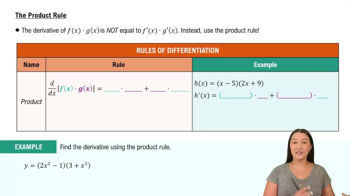Table of contents
- 0. Functions7h 52m
- Introduction to Functions16m
- Piecewise Functions10m
- Properties of Functions9m
- Common Functions1h 8m
- Transformations5m
- Combining Functions27m
- Exponent rules32m
- Exponential Functions28m
- Logarithmic Functions24m
- Properties of Logarithms34m
- Exponential & Logarithmic Equations35m
- Introduction to Trigonometric Functions38m
- Graphs of Trigonometric Functions44m
- Trigonometric Identities47m
- Inverse Trigonometric Functions48m
- 1. Limits and Continuity2h 2m
- 2. Intro to Derivatives1h 33m
- 3. Techniques of Differentiation3h 18m
- 4. Applications of Derivatives2h 38m
- 5. Graphical Applications of Derivatives6h 2m
- 6. Derivatives of Inverse, Exponential, & Logarithmic Functions2h 37m
- 7. Antiderivatives & Indefinite Integrals1h 26m
- 8. Definite Integrals4h 44m
- 9. Graphical Applications of Integrals2h 27m
- 10. Physics Applications of Integrals 2h 22m
6. Derivatives of Inverse, Exponential, & Logarithmic Functions
Logarithmic Differentiation
Problem 3.9.55
Textbook Question
49–55. Derivatives of tower functions (or g^h) Find the derivative of each function and evaluate the derivative at the given value of a.
f (x) = (4 sin x+2)^cos x; a = π
 Verified step by step guidance
Verified step by step guidance1
First, recognize that the function f(x) = (4 sin x + 2)^cos x is a tower function, which can be expressed in the form g(x)^h(x). To differentiate this type of function, use the logarithmic differentiation method.
Take the natural logarithm of both sides: ln(f(x)) = ln((4 sin x + 2)^cos x). This simplifies to ln(f(x)) = cos x * ln(4 sin x + 2) using the property of logarithms ln(a^b) = b * ln(a).
Differentiate both sides with respect to x. For the left side, use the chain rule: d/dx[ln(f(x))] = (1/f(x)) * f'(x). For the right side, apply the product rule: d/dx[cos x * ln(4 sin x + 2)] = -sin x * ln(4 sin x + 2) + cos x * (1/(4 sin x + 2)) * (4 cos x).
Solve for f'(x) by multiplying both sides by f(x): f'(x) = f(x) * [-sin x * ln(4 sin x + 2) + cos x * (4 cos x)/(4 sin x + 2)].
Finally, evaluate f'(x) at x = π. Substitute x = π into the expression for f'(x) and simplify. Remember that sin(π) = 0 and cos(π) = -1, which will help simplify the calculations.
 Verified video answer for a similar problem:
Verified video answer for a similar problem:This video solution was recommended by our tutors as helpful for the problem above
Video duration:
15mPlay a video:
Was this helpful?
Key Concepts
Here are the essential concepts you must grasp in order to answer the question correctly.
Chain Rule
The Chain Rule is a fundamental differentiation technique used to find the derivative of composite functions. It states that if a function y is composed of another function u, then the derivative of y with respect to x can be found by multiplying the derivative of y with respect to u by the derivative of u with respect to x. This rule is essential for differentiating functions like f(x) = (4 sin x + 2)^(cos x), where both the base and the exponent are functions of x.
Recommended video:

Intro to the Chain Rule
Product Rule
The Product Rule is used to differentiate products of two functions. If u(x) and v(x) are two differentiable functions, the derivative of their product is given by u'v + uv'. This rule is particularly relevant in the context of the given function, as it involves differentiating the base and the exponent, both of which are products of functions themselves.
Recommended video:

The Product Rule
Exponential Functions and Logarithmic Differentiation
Exponential functions, particularly those in the form of g^h, where both g and h are functions of x, can be differentiated using logarithmic differentiation. This technique involves taking the natural logarithm of both sides, simplifying the expression, and then differentiating. This method is useful for the function f(x) = (4 sin x + 2)^(cos x) because it allows for easier manipulation of the exponent and base during differentiation.
Recommended video:

Logarithmic Differentiation

 6:30m
6:30mWatch next
Master Logarithmic Differentiation with a bite sized video explanation from Callie
Start learningRelated Videos
Related Practice


